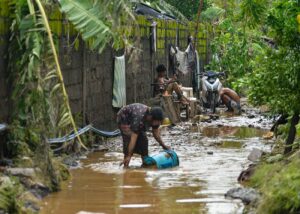
Guest post: How adaptation has cut flood deaths and losses in Europe

Dr Dominik Paprotny
09.09.25
Dr Dominik Paprotny
09.09.2025 | 3:35pmWhen flooding strikes, it can devastate vast areas, taking lives, homes and possessions with it.
Multiple factors affect the scale of the social and economic damage that flooding causes, such as climate change, land-use change and the flood protection measures in place.
In a new study, published in Science Advances, my colleagues and I attempt to disentangle the factors contributing to more than 1,700 floods in Europe over 1950-2020.
Our findings show that there has been an overall reduction in deaths and economic damage over this 70-year period – even though population and economic growth means the maximum value of possible losses has increased.
This is linked to the extent to which society has adapted to climate change.
Our study finds that – in most regions – flood impacts have been affected primarily by direct human actions, such as land-use change, vulnerability reduction and catchment alteration, rather than long-term changes to river levels or sea levels.
Other factors, including climate change and alterations to river catchments, had an important role in certain places, but were not a factor on a continent-wide scale.
What influences flood losses?
Dozens of floods occur in Europe every year, though the magnitude of the socioeconomic impacts they cause varies considerably from year to year.
Floods can happen in any country, though they are less common in north-eastern Europe, especially since climate change has reduced snow cover and, hence, reduced spring snowmelt. In the hot and mountainous south of Europe, flash floods are a major risk, causing most fatalities in Europe. In north-western Europe the risk of coastal flooding, increased by global sea level rise, is higher than in other parts of the continent.
Our study looks at 1,729 floods that took place across Europe over a 70 year-period, drawn from the Historical Analysis of Natural Hazards in Europe (HANZE) database. We estimate that this list covers the vast majority of all flood impacts in Europe since 1950.

We find that, in absolute terms, direct economic damage from floods in Europe has increased considerably, from an estimated €37bn in the 1950s (at 2020 prices) to €92bn in the 2000s and €71bn in 2010s.
Yet, in relative terms, the annual losses from floods have fallen. Direct economic damage from floods fell to 0.04% of Europe’s gross domestic product (GDP) in the 2010s, down from 0.11% in the 1950s.
Meanwhile, the risk of dying in a flood has also declined more than six-fold since the 1950s.
Six long-term drivers
First, it is worth noting that each of the 1,729 events in our study were the result of a unique combination of natural and socioeconomic factors under various flood management regimes.
However, we can explore how trends in economic and social damages from floods across Europe have been influenced by different drivers. For this, we turn to the evolving science of attribution research.
Extreme weather attribution research covers a diverse set of qualitative and quantitative approaches to estimate the contribution of individual drivers – such as climate change or socioeconomic factors – to observed impacts. Most studies focus on attribution to climate change, but such approaches are often insufficient to explain the magnitude of flood losses.
Our study investigates six long-term drivers that could have explained the trends in flood impacts in Europe over a 70-year period. These are:
- Long-term climate change
- Human interventions in river catchments
- Population and economic growth
- Land-use change
- Flood protection levels
- Flood vulnerability
To do so, we use hydrological and socioeconomic models driven by observations of climate, economic and other trends.
In all cases, we evaluate the drivers against the climate and socioeconomic conditions of the year 1950 to capture how their importance might have changed over time.
The first driver we look at – and the one that is typically of most interest in attribution studies – is long-term changes to the climate. This includes changes in the probability of extreme river discharges, storm surges, wave heights and global sea level rise.
The study looks at both the fingerprint of human-caused climate change – the 1950-2020 period is when most of global warming has occurred – but also incorporates natural variations of the climate.
Here, we find climate change has mostly worsened flood impacts, especially for levels of economic damage.
However, there is strong variation in Europe. While climate change has led to more substantial flood impacts in north-west Europe, the inverse was true for several countries in southern Europe. This is largely due to an increase in the dryness of the climate.
Human factors
Next we look at human interventions in river catchments, such as reservoir construction and land-use change, which alter the movement and distribution of water across large areas.
Here, we find that these interventions had opposite effects.
Across Europe, land-use change contributed to larger flood impacts over the study period. This was largely due to a rapid increase in “soil sealing” – the covering of soil for housing, roads or other construction work.
However, the construction of large reservoirs – most of which were built after 1950 – has reduced flood volumes, helping to reduce flood impacts, particularly in central Europe.
Population growth has increased flood impacts in almost all countries (with the main exception being Germany because of population decline in the east of the country). In addition, economic growth means the maximum value of possible losses to floods – or “flood exposure” – has increased across the continent.
That said, when considering losses relative to the size of the economy or population, the change in spatial distribution of people becomes more important.
For example, there has been more development in floodplains than outside of them, which – when combined with structural factors, such as the shift from agriculture to industry and from industry to services – has contributed to an overall increase in flood impacts.
However, this did not occur in all countries and did not apply to fatalities, which narrowly reduced across Europe over the study period due to changes in population distribution.
Adaptation
The final two drivers investigated were related to how society has adapted to flood risks.
One method is improving structural flood protection through dykes and reservoirs. (In a 2024 study, we estimated that flood protection has improved in Europe since 1950, even if more for coastal than river floods.)
We also see this effect in this study, though it is not as pronounced. This is because we only look at floods that did occur – meaning that protection measures were not sufficient to prevent them.
Nonetheless, we find that better protection has reduced the extent and, therefore, the impact of floods in most European countries, except some in central and northern Europe.
Our final driver was vulnerability to floods, defined as the relative impact of flooding on population and assets at a given hydrological intensity.
This factor heavily depends on the level of preparedness and adaptation as well as the capacity to respond to a flood. For instance, small adaptations of buildings that prevent water from flowing into it could substantially reduce the share of the building value that is lost in the flood.
In the most recent decade, floods caused an estimated 74-75% fewer fatalities and smaller economic loss than if they happened in 1950 at the same level of exposure – thanks to lower vulnerability. This reduction was found across the continent – indicating that certain universal changes were responsible for this process.
Our study was not able to link this progress to individual measures, but obvious candidates are creation of early warning systems, more capable emergency services, improved disaster response and uptake of private precautionary measures by households and companies after previous experiences of flooding.
The figure below shows the contribution of the six drivers (from left to right) for three types of impacts: fatalities (top), population affected (middle) and economic losses (bottom) to all floods that have occurred in each country between 1950 and 2020.
The shading indicates whether the driver increased (red) or decreased (blue) impacts.

Solutions reaching their limit?
Our findings indicate the crucial role that adaptation has had on containing growth in flood losses that could have been induced by a larger population and economy.
Still, this positive development should not be taken for granted. Our results show a considerable slowdown in the reduction of losses from better flood protection or lower levels of vulnerability in the most recent two decades. This could indicate that existing solutions are reaching their limits.
However, we find that southern and eastern Europe still has higher vulnerability compared with western Europe – showing potential for further improvements in those regions.
Recent major floods, such as the 2021 event in western Europe, have raised questions about existing levels of preparedness, while highlighting the role of climate change in increasing the impacts of those events.
Our study shows that adaptation works in Europe, but that greater efforts will be needed to ensure it continues to do so.
Paprotny, D et al. (2025). Attribution of flood impacts shows strong benefits of adaptation in Europe since 1950, Science Advances, doi: 10.1126/sciadv.adt7068





